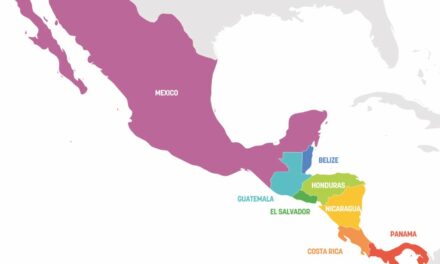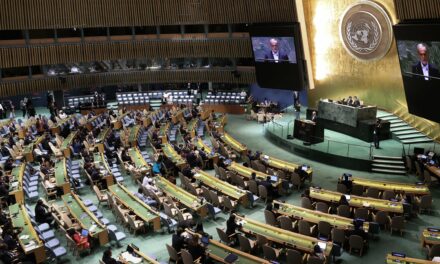We support our Publishers and Content Creators. You can view this story on their website by CLICKING HERE.
Arizona and Nevada not only are major battlegrounds in the presidential race, but voters there also will decide Nov. 5 whether the two states will adopt some incarnation of the process known as ranked choice voting.
Six western states and the District of Columbia will vote on some form of ranked choice voting or “jungle primary” that includes ranking the final candidates, according to Ranked Vote and Unite America, which advocate the alternate election process.
Another state will consider ditching the ranked choice system.
In most states, supporters and opponents of ranked choice voting don’t break down along traditional party lines. In several states, in fact, both the Democratic and Republican parties oppose the process.
The other states considering ranked choice voting in November are Colorado, Idaho, and Oregon.
In Alaska, voters will consider repealing a law providing for ranked choice voting. Enough Alaskans have buyer’s remorse after adopting ranked choice voting four years ago that it’s on the ballot again.
The ballot initiatives seemingly go against a trend in which 10 state legislatures have banned ranked choice voting
“We’ve seen legislatures ban ranked choice voting in several states, but ballot measures seem to have a mind of their own,” Jason Snead, executive director of the Honest Elections Project and an opponent of ranked choice voting, told The Daily Signal.
“There has been massive spending on some of these initiatives.” Snead said. “People are actually seeing a small cabal of donors that want to weaken political parties. Progressive donors want to take control of the political process at the expense of political parties.”
Two organizations, United America PAC and Article IV, are the leading funders of related ballot initiatives in some states.
Supporters of ranked choice voting are outspending opponents by at least 2 to 1, and often 10 to 1, according to campaign finance reports cited by Ballotpedia.
United America released a study this month finding that 87% of the races for the U.S. House of Representatives are determined by 7% of voters during primary elections. The political action committee contends this shows the need for a primary system that advances the top finishers to the general election.
Ranked choice voting advocates support a top four or top five system.
“These numbers speak to the despair many Americans have that their vote does not seem to matter,” said Nick Troiano, executive director of Unite America, in a public statement. “But with a record number of open primary initiatives on the ballot this November, our movement is proving it doesn’t have to be this way.”
All the jurisdictions considering ballot measures on ranked choice voting currently have party primaries; the two nominees who emerge in the primaries face off in November.
Ranked choice voting has been implemented in marginally different ways in various jurisdictions. Generally, though, voters are asked to rank their first, second, and third choices on the ballot.
If no candidate gets more than 50% to finish in first place, a second round of counting occurs. Gradually, candidates who come in last place after each round are eliminated.
The voter’s second choice will be counted if his or her ballot lists an eliminated candidate as the first choice. More rounds of voting continue until one candidate has a majority.
Here’s a look at states with ballot measures related to ranked choice voting.
Arizona’s Proposition 140
Arizona voters will approve or reject Proposition 140, which would establish primaries in which candidates would appear on a single ballot regardless of party affiliation. The top finishers would go on to the general election.
The measure also would require one candidate to win a majority of the vote in the general election. If three or more candidates advance to a general, it would require ranked choice voting.
If approved, the measure would amend the state Constitution regarding how primary and general elections are run.
Arizona currently has party primaries, in which Republicans vote in one primary and Democrats vote in another. The winner of the Republican primary becomes the GOP nominee for a specific office in the general election. Similarly, the winner of the Democratic primary becomes that party’s nominee for a specific office in the general.
Supporters of the ballot question, led by Make Elections Fair PAC, have raised $9.9 million, according to Ballotpedia. Opponents, led by the No on Prop 140 Committee, raised $5 million.
Nevada’s Question 3
Nevada voters are considering Question 3, a ballot measure that would move the state to a “top five” primary if approved.
The change in law would allow the Nevada Legislature to decide how many candidates for an office—between two and five—advance to the general election.
Nevada voters approved the measure once in 2022. Because the measure would amend the Nevada Constitution, however, it must go before voters twice.
“If it passes this time, it goes into effect in the 2026 election for congressional and statewide elections,” John Tsarpalas, president of Nevada Policy Research Institute, a conservative think tank, told The Daily Signal.
Tsarpalas noted that this year, the Democratic, Republican, Libertarian, and Green parties all formally oppose the ballot question.
“The reason for this is supporters of the measure want to destroy the political parties,” Tsarpalas said. “They believe it will make it easier to elect more moderate candidates. But in a ranked choice voting final five system, if nobody gets more than 50% in the first round, some revotes will count and some won’t.”
It’s not unusual for a constitutional amendment to fail on the second try, he noted.
“Usually, the ‘no’ side ramps up the second time,” Tsarpalas said. “The ‘yes’ side is only talking about an open primary. It’s not talking as much about ranked choice voting.”
Nevertheless, supporters of the Nevada measure have raised $22.9 million while opponents raised $2.42 million, according to Ballotpedia.
Advocates of the ballot question include the Institute for Political Innovation, Represent.Us, and Vote Nevada, all center-left groups that say they advocate democratic reforms.
Still, the two Democrats who represent Nevada in the U.S. Senate, Catherine Cortez Mastro and Jacky Rosen, oppose the measure. So do the liberal Nevada AFL-CIO and the conservative Americans for Tax Reform.
Montana’s Two Proposals
Montana isn’t a swing state in the presidential race, but has a closely contested Senate race.
Voters in Montana will decide two ballot initiatives related to ranked choice voting Nov. 5, both proposed amendments to the state Constitution.
Constitutional Initiative 126 would establish a “top four” primary that excludes party affiliations. If approved, it would apply to elections for Congress and for state offices such as governor and the Legislature.
The top four vote-getters in the primary would advance to the general election, but a plurality winner there could be elected to office. That’s where the next initiative comes in.
Constitutional Initiative 127, if approved, would require certain public offices to be decided by a majority of voters, rather than a plurality.
This second proposal wouldn’t solve how to select a winner when no candidate gets a majority. If approved, the Legislature could choose either a runoff system or ranked choice voting.
The groups Article IV and Unite America are the biggest donors to the effort in Montana.
Supporters of the two ballot initiatives, led by Montanans for Election Reform, raised $7.3 million. Opponents, led by Montanans for Fair Elections, raised just over $3,000, according to Ballotpedia.
Colorado’s Proposition 131
Proposition 131, if approved by Colorado voters, would replace two separate party primaries with a single “top four” primary where four finalists from either party would move to the general election.
The general election would be decided by ranked choice voting rules. The change would apply to state and federal elections, but not to presidential primaries or presidential general elections.
If approved by voters, the change reportedly would cost state taxpayers $6 million per year to implement.
Colorado Gov. Jared Polis and Sen. John Hickenlooper, both Democrats, endorsed the shift to ranked choice voting, according to Ballotpedia. Former Rep. Ken Buck, a Republican, also supports the change, as do the state’s Chamber of Commerce and League of Women Voters.
Opponents include Colorado’s Republican and Democratic parties, as well as Sen. Michael Bennet, a Democrat, and Reps. Lauren Boebert and Diana DeGette, both Republicans.
Also opposing the measure are the Colorado AFL-CIO and the state chapter of the American Federation of Teachers.
Idaho’s Proposition 1
If Idaho voters approve it, Proposition 1 would replace two separate party primaries with a single “top four” primary system. The top four finalists would advance to a general election using ranked choice voting.
The change would apply to candidates for congressional, gubernatorial, and other state and county elected offices.
The proposal reads: “Candidates could list any affiliation on the ballot, but would not represent political parties, and need not be associated with the party they name.”
In 2023, the state Legislature banned ranked choice voting. Idaho is one of 10 states to have done so.
In this heavily GOP state, former Gov. Butch Otter, a Republican, endorsed the measure.
The lead supporter of the ballot question is Idahoans for Open Primaries, which has raised $960,000, according to Ballotpedia.
Oregon’s Measure 117
Oregon voters will decide Measure 117, which would implement ranked choice voting.
While most other ballot proposals were the result of citizen petitions, the Oregon Legislature passed legislation known as HB 2004 to put ranked choice voting on the ballot. This is a first, according to Ballotpedia.
If approved, the ballot measure would apply only to congressional and state races in Oregon. But it also would authorize cities and counties to adopt ranked choice voting.
Backers include the Oregon chapter of the American Federation of Teachers as well as Common Cause and the League of Women Voters. Opponents include the Equal Vote Coalition, the Oregon Association of County Clerks, and the Taxpayers Association of Oregon.
Supporters spent $1.9 million while opponents raised just $50, according to Ballotpedia.
Alaska’s Measure 2
Voters in Alaska will have the option to repeal a “top four” ranked choice voting law by approving Measure 2.
The measure would return Alaska to partisan primaries, after which a winning Republican and a winning Democrat (or various third party-fielded candidates) would face off in a general election.
A candidate could win by attracting a plurality of votes.
In 2020, Alaska voters approved ranked choice voting, in which the top four candidates from an open primary compete in a general election. Voters then rank the four by preference.
Advocates of ranked choice voting raised $12.9 million to defeat the measure, compared with $489,888 by supporters of Measure 2, according to Ballotpedia.
“Out-of-state groups have brought in $12 million to stop the repeal,” Phillip Izon, lead organizer of Alaskans for Honest Elections, told The Daily Signal. “Even [Sen. Lisa] Murkowski didn’t raise that much. In Oregon, the ranked choice voting initiative only spent $2 million. In Montana, they only spent $5 million.”
In 2020, Izon said, about $7 million—mostly from out of state—
promoted the measure in a way that rarely mentioned ranked choice voting.
“It passed because they promoted it as getting rid of dark money,” Izon said.
The biggest donors opposing Measure 2 are Article IV, a group that says it includes Democrats, Republicans, and independents who favor reforms, and the Unite America PAC, a political action committee that supports center-left candidates and policies. Both groups donated more than $4 million to defeat the measure.
The biggest donor backing Measure 2 is the Ranked Choice Education Association, which spent $152,000.
D.C.’s Initiative 83
Voters in the nation’s capital will decide Initiative 83, which if approved would allow unaffiliated voters to vote in a party primary. It also would establish ranked choice voting for general elections beginning in 2026.
In the District of Columbia, a mostly one-party jurisdiction, approval of the ballot question would be a blow to the dominant Democrats.
Supporters include the groups Fair Vote and RepresentUs.
Opponents include the Democratic Party of Washington, D.C.
Supporters raised $983,171 to opponents’ $2,463, according to Ballotpedia.

 Conservative
Conservative  Search
Search Trending
Trending Current News
Current News 





